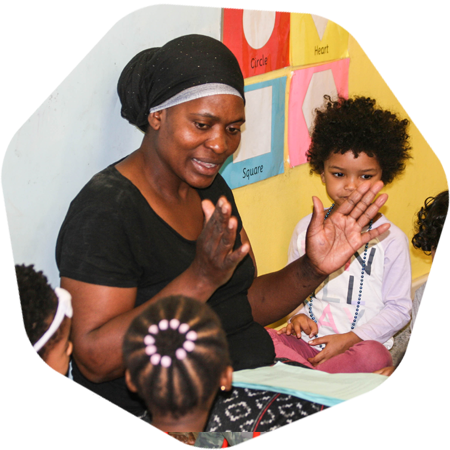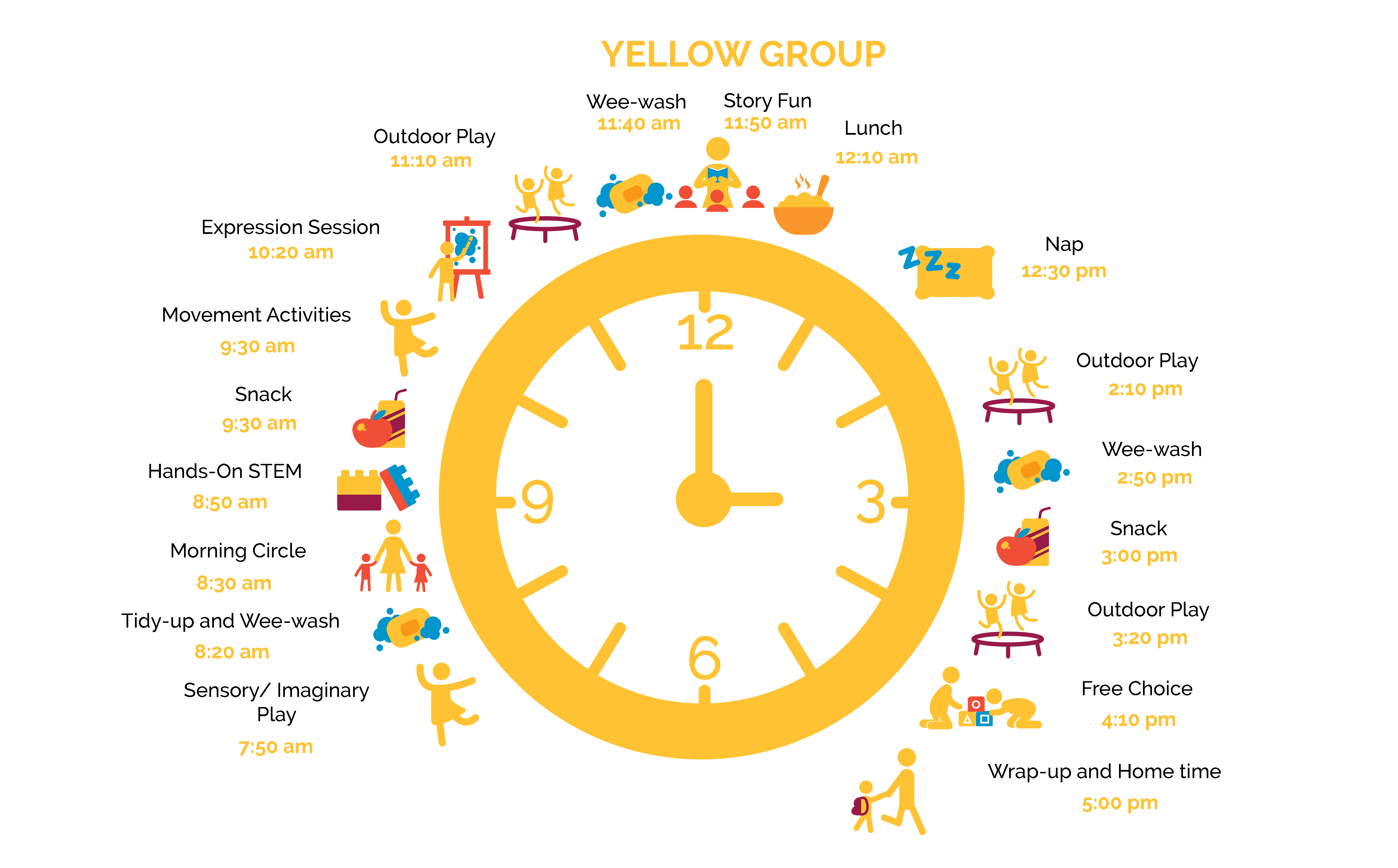
Yellow Group: Turning Three
Yellow group kiddos really get the hang of the daily routine and begin to thrive in particular elements, such as creative expression, early STEM, and emergent literacy as their particular strengths and preferences shine through.
Enrol my child now
Yellow Group Daily Routine:

Development and Learning Objectives for the Yellow Group:
Language, Literacy and Creative Expression
Maths and Scientific Reasoning
Physical, Social and Emotional well-being
 Language, literacy and creative expression
Language, literacy and creative expression
Engages in music, art and dramatic play
1e. Demonstrates a sense of rhythm and has the ability to copy or join in on a specific sequence of beats/sounds.
1f Dresses up as / pretends plays in the role of real and fictional characters.
1g. Begins to use art materials (such as crayons, paint, play dough, etc.) to create representations of real/imagined objects, people, and scenes
1h. Mimics dance moves of others.
Receptive & Expressive vocabulary development
2h. Learns 3 or more new words per week
2i. Uses new vocabulary words in correct context in phrases / sentences.
Coherent expression of personal ideas, thoughts, feelings
3f. Expresses a full sentence of coherent thoughts in response to questions.
Response to Text
4c Makes meaningful connections between parts of story and own experiences or experiences of others.
4d Pretends to be reading a storybook and/or plays as if reading aloud from a book while paging through and using pictures cues.
Phonological Awareness
5d. Identifies a sound within a word.
5e. Counts syllables and compares word lengths.
Phoneme-Grapheme Correspondence
6a. Identifies onset sounds (and letter link for own name)
Print awareness / concepts
7b. Names parts of a book (front cover, title, author, illustrator etc.)
Tracing, transcription and writing
8b. Scribbles letter-like symbolic representations, imitating the writing process; traces letter shapes in the air
 Maths and Scientific Reasoning
Maths and Scientific Reasoning
Estimation
9a. Able to discern between many and few.
Verbal and object counting
10c. Counts in a ‘sing-song’ fashion up to 10; “”chanter/reciter””
10d. Tries to independently keep track of a small number of objects during a game, using counting and quantity matching, up to 5.
10e. Understands concepts of first, second, third (ordinal numbers).
Numeral recognition, depiction and quantity correspondence (cardinality)
11a. Numeral recognition from 1 to 10
11b. Beginning understanding of cardinality (the ability to associate the numerals 1-5 with a correct corresponding quantity of objects)
Relative Magnitude and Measurement
12c. Indicates relative height of two people / objects (taller, shorter)
Shape recognition and manipulation
13c. Sorts shapes according to basic characteristics (e.g. round sides, sharp corners, straight edges).
Position, Direction, Orientation, and Time
14a. Display understanding of the position of an object relative to themselves or another object from one perspective using spatial vocabulary such as ‘above’ , ‘below’, ‘beside’, ‘in front’, ‘behind’
14b. Describes the position of an object relative to themselves other objects from multiple perspectives
14c. Differentiates between ‘first’, ”middle’ and ‘last’ in the line
Classification and Repeat Patterning
15b. Identifies and continues a-b-a-b style patterns.
15c. Groups physical objects based on simple observable characteristics (particularly colour)
Planning and Cognitive Flexibility
16b. Routinely describes action plan prior to and during morning free choice activities
Hypothesis formation
17c. Comes up with ideas for the possible causes of observed phenomena with prompting/support.
 pHysical and social emotional wellbeing
pHysical and social emotional wellbeing
Self-regulation
18g. Self-soothes when upset; does not lash out on/at others.
18h. Practices sharing and cooperates with peers during group activities.
Response to expectations
19d. Is aware of (i.e. can describe) classroom routines and behavioral norms.
19e. Is able to identify own belongings and take care of them independently
Positive sense of self
20c. Describes own feelings (in words) and identifies possible sources.
Persistence in the face of challenges
21c. Engages in tasks above comfort level with minimal prompting and seeks support when battling, rather than giving up.
Gross motor coordination
22q. Catches a bean bag / ball two handed
22r. Kicks a ball towards an intended target.
22s. Blances on one foot for at least 5 seconds.
Fine motor coordination
23q. Manipulates a paintbrush effectively to dip in a paint pot without spilling and paint on intended surface.
23r Uses scissors to cut along a straight line.
23s. Threads beads onto a string.
23t. Opens and closes zips and buttons on clothing to dress independently.